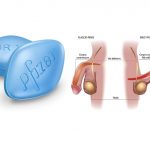Is Tamsulosin Like Viagra?

Tamsulosin and Viagra are two medications that have significantly impacted the lives of millions of individuals worldwide. While they serve entirely different purposes and belong to distinct drug classes, both have proven to be effective in treating specific medical conditions.
This article aims to provide an in-depth analysis of Tamsulosin and Viagra, exploring their unique characteristics, uses, mechanisms of action, potential side effects, and more. Through this comprehensive comparison, we hope to shed light on the distinct roles these drugs play in medical practice.
Understanding Tamsulosin and Viagra
Tamsulosin and Viagra are both medications used to treat different medical conditions, and they have distinct mechanisms of action. However, there is one aspect in which they share some similarity – their impact on smooth muscle relaxation. Let’s explore this similarity in more detail:
Tamsulosin is classified as an alpha-1 adrenergic receptor antagonist. It is primarily used to treat benign prostatic hyperplasia (BPH), a condition characterized by the enlargement of the prostate gland in men, which can lead to urinary symptoms such as difficulty urinating, weak stream, and frequent urination. The prostate gland surrounds the urethra, and when it becomes enlarged, it can obstruct the flow of urine.
Tamsulosin works by selectively blocking alpha-1 adrenergic receptors in the smooth muscle of the prostate gland, as well as the neck of the bladder and the urethra. By doing so, it causes relaxation of these smooth muscles, which helps to relieve the pressure on the urethra, improving the flow of urine and reducing urinary symptoms in men with BPH. Notably, it does not shrink the actual size of the prostate gland.
Viagra, on the other hand, is a medication used to treat erectile dysfunction (ED) in men. ED is a condition where a man has difficulty achieving or maintaining an erection sufficient for sexual intercourse. The active ingredient in Viagra is sildenafil, a phosphodiesterase type 5 (PDE5) inhibitor. During sexual arousal, nitric oxide (NO) is released in the erectile tissue of the penis, which stimulates the production of cyclic guanosine monophosphate (cGMP). cGMP is responsible for relaxing the smooth muscle cells in the penile blood vessels, allowing increased blood flow into the penis and resulting in an erection.
PDE5 is an enzyme that breaks down cGMP, leading to the termination of the erection. Sildenafil inhibits PDE5, allowing cGMP to persist for a longer duration, enhancing the erectile response to sexual stimulation. This increased blood flow to the penis helps men with ED to achieve and maintain erections.
Does Tamsulosin Work Like Viagra?
No, tamsulosin is not like Viagra even though they both exert their therapeutic effects by inducing relaxation of smooth muscles, albeit in different parts of the body. Tamsulosin targets the smooth muscle in the prostate, bladder neck, and urethra, leading to improved urine flow, while Viagra targets the smooth muscle in the penile blood vessels, enhancing blood flow and facilitating erections in men with ED.
A study published in the Arab Journal of Urology which compared Viagra combination with tamsulosin and tamsulosin monotherapy to manage male lower urinary tract symptoms reported that using both tamsulosin and Viagra can improve erectile function by enhancing blood flow to the penis.
It’s essential to note that despite this similarity in smooth muscle relaxation, Tamsulosin and Viagra have different therapeutic applications, and they are not interchangeable. Tamsulosin is specifically for BPH, and Viagra is only for ED. Both drugs have their own set of potential side effects and contraindications, and they should be used only as prescribed by healthcare professionals.
Does Tamsulosin Have The Same Side Effects Like Viagra?
Tamsulosin and Viagra have different side effect profiles. While they do not share identical side effects, some adverse effects may be seen with both drugs. Let’s explore the common and unique side effects of each medication:
Common Side Effects of Tamsulosin:
1. Dizziness or lightheadedness
2. Headache
3. Runny or stuffy nose
4. Weakness or fatigue
5. Abnormal ejaculation (e.g., retrograde ejaculation)
6. Low blood pressure (orthostatic hypotension)
7. Gastrointestinal disturbances (nausea, diarrhea)
Common Side Effects of Viagra (Sildenafil):
1. Headache
2. Flushing (reddening of the face)
3. Indigestion or upset stomach
4. Nasal congestion
5. Changes in vision (blurred vision, blue-tinted vision, sensitivity to light)
6. Back pain or muscle pain
7. Dizziness or lightheadedness
Unique Side Effects of Tamsulosin:
1. Dizziness upon standing (orthostatic hypotension)
2. Retrograde ejaculation (semen going backward into the bladder instead of out through the penis)
3. Allergic reactions (rare but possible)
4. In rare cases, priapism (painful and prolonged erection not related to sexual stimulation) may occur.
Unique Side Effects of Viagra (Sildenafil):
1. Visual disturbances (notably, blue-tinged vision)
2. Priapism (a prolonged and painful erection unrelated to sexual arousal) – this side effect is rare but considered a medical emergency if it occurs.
It’s important to note that not everyone will experience side effects from these medications, and side effects, when they occur, tend to be mild and temporary. Additionally, some side effects may be more common in certain individuals or specific patient populations.
While Tamsulosin and Viagra have some side effects in common, they are prescribed for entirely different medical conditions (BPH and ED, respectively), and their mechanisms of action are distinct. Therefore, it’s crucial to follow the prescribed dosages, use these medications as directed by a healthcare professional, and report any unusual or severe side effects promptly.
Always consult your healthcare provider before starting or stopping any medication, and inform them of any existing medical conditions, allergies, or medications you are currently taking to avoid potential interactions and adverse effects.
Can You Take Tamsulosin And Viagra Together?
No, combining Tamsulosin and Viagra (sildenafil) is generally not recommended without the explicit approval and supervision of a healthcare professional. Both medications can have an impact on blood pressure, and their simultaneous use may result in a significant drop in blood pressure, leading to serious health risks.
Tamsulosin is an alpha-1 adrenergic receptor antagonist that relaxes smooth muscle in the prostate, bladder neck, and urethra. One of its side effects is a decrease in blood pressure, which can cause dizziness or fainting, especially when standing up quickly (orthostatic hypotension).
Viagra, on the other hand, is a phosphodiesterase type 5 (PDE5) inhibitor that enhances blood flow to the penis, aiding in the treatment of erectile dysfunction. One of its side effects is also a decrease in blood pressure, and it should not be taken with nitrates (commonly used for heart conditions) due to the risk of a severe drop in blood pressure.
However, the study referenced above suggests that the combination of sildenafil citrate (the active ingredient in Viagra) with tamsulosin can lead to improvements in lower urinary tract symptoms (LUTS), erectile function, and patient quality of life (QoL) in individuals with LUTS and benign prostatic hyperplasia (BPH) compared to tamsulosin monotherapy. Additionally, it implies that the combination therapy has a comparable safety profile to tamsulosin alone.
If you are experiencing both benign prostatic hyperplasia (BPH) and erectile dysfunction (ED), it is essential to discuss your symptoms and medical history with your doctor. They will consider all relevant factors and may prescribe an appropriate treatment plan that addresses both conditions safely. This could involve using alternative medications or adjusting dosages to minimize potential risks.
Your healthcare provider will consider any pre-existing medical conditions, current medications, and overall health status before recommending a suitable treatment regimen. Never self-prescribe or take medications together without proper medical guidance, as it may lead to adverse reactions and potentially harmful consequences. Always follow your doctor’s instructions and inform them of any changes or concerns you may have during the course of treatment.





